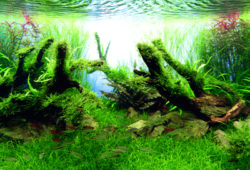Arowana Fish: An Aquatic Nobility
In the article I’m going to tell you about Arowana Fish: An Aquatic Nobility. Keeping fish as pets is a hobby that traces its origins to the fascination of people to wondrous water creatures. While there is a long list of aquatic pets people choose to keep, there are few creatures that come close to the fascination and interest aquarists show towards arowana fish.

Contents
Prehistoric Creatures
Looking at an arowana fish is like taking a glimpse at a living fossil which dates back to prehistoric times. Considering the fact that its ancestors first appeared in bodies of freshwater more than a hundred million years ago, the arowana and the several species that belong to its family is quite adaptive, standing the test of time and earning its rightful place as an aquatic nobility. By merely looking at it, you will definitely see several extraordinary and prehistoric features which only existed when dinosaurs walked the Earth.
Its flawless armor of tough scales resemble that of an Asian dragon and its similarity to the said mythological creature is the same reason why it became revered as a symbol of power and prosperity, even earning the nickname the ‘Dragon Fish’. Its resemblance to the Asian Dragon is even more apparent once its double barbels and fins are showcased, imitating a dragon in flight.
Unique Features of Arowana Fish
The large scales of the arowana come in a variety of colors depending on the species. It ranges from silver, to green, to the most sought after deep red. Some species even possess noticeable difference in the scales where a distinct variation of color appears on each part of its body. Upon closer inspection, the scales of the arowana form a unique mosaic pattern, while individual scales also show off a very intricate, net-like pattern.Their long and bony bodies are very distinct.
The biggest of the arowana species can grow up to 4 feet long (121.9 cm) in the wild but when kept in an aquarium, it can reach up to 30 inches long (76.2 cm) which still makes them bigger than most aquatic pets. The head of the arowana fish is what most consider as bony, with an unusual bony ‘tongue’ which in reality, is a bone filled with teeth. This special featured earned the arowana their nickname ‘bonytongue’. In the scientific world however, they are called Osteoglossids.
Download the Complete Set of Arowana Care Guides Today!
Arowana Fish Fast Facts
Arowanas are native to some parts of the globe which includes Asia, Africa, Australia and South America. There are about 10 known species of arowana (affiliate link). Four of those can be found all around Asia while three species can be found in South America. There is also a couple of arowana varieties found on the Australian continent while a single species inhabits the large freshwater basins of Africa.
Arowana fish thrive in the abundance of freshwater and have very low tolerance to salt water. Like most fish, bonytongues are facilitative air breathers which means they only breathe air at their will. Otherwise, they will use their gills to obtain their much needed supply of oxygen. Having such ability lessens their stay on the surface of the water, preventing predators from feeding on them. This behavior is quite contrary to their eating habits because arowanas are known as surface feeders.
They are known as mainly carnivorous and often feed on smaller fish, prawns, insects and at times, even on birds. They manage to catch insects and other non-aquatic creatures by stalking them on the surface and leaping as high as a couple of inches to catch their prey. When kept in aquariums however, arowanas can be fed a staple of live or frozen food. With their huge appetite and fast pace of growth, they can easily outgrow mid-sized home aquariums within a year. Arowanas are known to live up to 20 years or more which makes them ideal for those who choose to keep them as treasured possessions.
Keeping Arowanas as Pets
As aquarium pets, they prefer to live solitary. Most species of arowana fish tend to be aggressive and hostile towards other fishes and won’t think twice about eating any other creature that fits in their mouth. That is why most homeowners who keep arowanas in their aquarium should think twice before putting another species of fish in the same tank. There are only a handful of compatible fish which can live side by side with bonytongues such as siamese tigerfish, oscars and clown knifefish. As a general rule, aquarium owners must not put a similarly dominant species of fish in the same aquarium as arowanas nor should the owner place any other kind of fish which can easily fit in the arowana’s mouth.
Amidst such characteristics of the arowana fish, a lot of people still love to keep them as aquarium pets. This is due to the fact that they are fairly easy to take care of while serving as a beautiful addition to aquariums and fish tanks. It takes a long time however, for an aquarium owner to master the skills necessary to keep arowanas prime, healthy and beautiful. With the knowledge of how to properly care for them, aquarists and pet owners will find the various delights of keeping an arowana.
Only when aquarium owners are able to bring about the full potential of the arowana fish as a pet, will they truly understand why such creatures are considered an aquatic nobility.



